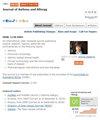A Longitudinal Study of a Selected Pediatric Asthmatic Population with Normal and Abnormal Spirometry at Baseline: An Emphasis on Treatment Outcomes
IF 3.7
3区 医学
Q2 ALLERGY
引用次数: 0
Abstract
Purpose: It is still unclear whether considering abnormal spirometry as a marker for disease control can help physicians adjust asthma controllers in children because of the scarcity of pediatric studies. We aimed to investigate the prevalence of abnormal spirometry in a selected pediatric asthmatic population and its effect on longitudinal outcomes.Patients and Methods: This retrospective cohort study was conducted at the Songklanagarind Hospital, Thailand. Children with asthma aged < 18 years were recruited for review if they attended the clinic and underwent acceptable spirometry with bronchodilator responsiveness (BDR) tests after receiving asthma treatment for at least 3 months between January 2011 and June 2022. Differences in baseline characteristics, atopic factors, asthma treatment, and outcomes were analyzed between the normal and abnormal spirometry groups over a 12-month post-spirometry period.
Results: The mean age of the 203 enrolled patients was 10.9 ± 2.6 years. Abnormal spirometry, defined as airflow limitation or the presence of BDR, was observed in 58.1% of patients. No significant differences were observed in baseline characteristics, atopic factors, asthma treatment, or outcomes between the normal and abnormal spirometry groups. Further analysis of 107 patients with abnormal spirometry with symptom control revealed that physicians adjusted the asthma controller based on spirometry and symptoms in 84 and 23 patients, respectively. There was no significant difference in the loss of disease control over the 12-month post-spirometry period between the two groups.
Conclusion: Abnormal spirometry was found in 58.1% of treated school-aged patients with asthma. Abnormal spirometry results were not associated with poor asthma outcomes during the 12-month follow-up. Both symptom-based and spirometry-based adjustments of asthma controllers resulted in comparable symptom control over a 12-month follow-up period in the selected population.
Keywords: pulmonary function test, lung function test, childhood asthma, bronchodilator responsiveness
对肺活量基线正常和异常的部分小儿哮喘患者进行纵向研究:强调治疗结果
目的:由于儿科研究较少,目前尚不清楚将肺活量异常作为疾病控制的标志物是否有助于医生调整儿童哮喘控制药物。我们旨在调查选定的儿科哮喘人群中肺活量异常的发生率及其对纵向结果的影响:这项回顾性队列研究在泰国宋克拉那加林医院(Songklanagarind Hospital)进行。2011年1月至2022年6月期间,年龄为18岁的哮喘患儿在接受至少3个月的哮喘治疗后,接受了合格的肺活量测定和支气管舒张剂反应性(BDR)测试。分析了肺活量正常组和肺活量异常组在肺活量测定后 12 个月内的基线特征、特应性因素、哮喘治疗和结果的差异:203 名入选患者的平均年龄为 10.9±2.6 岁。58.1%的患者出现肺活量异常,即气流受限或出现BDR。肺活量正常组和肺活量异常组在基线特征、特应性因素、哮喘治疗或疗效方面均无明显差异。对 107 例肺活量异常但症状得到控制的患者进行进一步分析后发现,医生分别根据 84 例和 23 例患者的肺活量和症状调整了哮喘控制药物。在肺活量测定后的 12 个月内,两组患者的疾病控制率没有明显差异:结论:在接受治疗的学龄哮喘患者中,58.1%的患者肺活量异常。结论:58.1%接受过治疗的学龄哮喘患者的肺活量出现异常,但肺活量异常结果与 12 个月随访期间的哮喘不良后果无关。根据症状和肺活量对哮喘控制者进行调整后,所选人群在12个月随访期间的症状控制效果相当。 关键词:肺功能测试;肺功能测试;儿童哮喘;支气管扩张剂反应性
本文章由计算机程序翻译,如有差异,请以英文原文为准。
求助全文
约1分钟内获得全文
求助全文
来源期刊

Journal of Asthma and Allergy
Medicine-Immunology and Allergy
CiteScore
5.30
自引率
6.20%
发文量
185
审稿时长
16 weeks
期刊介绍:
An international, peer-reviewed journal publishing original research, reports, editorials and commentaries on the following topics: Asthma; Pulmonary physiology; Asthma related clinical health; Clinical immunology and the immunological basis of disease; Pharmacological interventions and new therapies.
Although the main focus of the journal will be to publish research and clinical results in humans, preclinical, animal and in vitro studies will be published where they shed light on disease processes and potential new therapies.
 求助内容:
求助内容: 应助结果提醒方式:
应助结果提醒方式:


